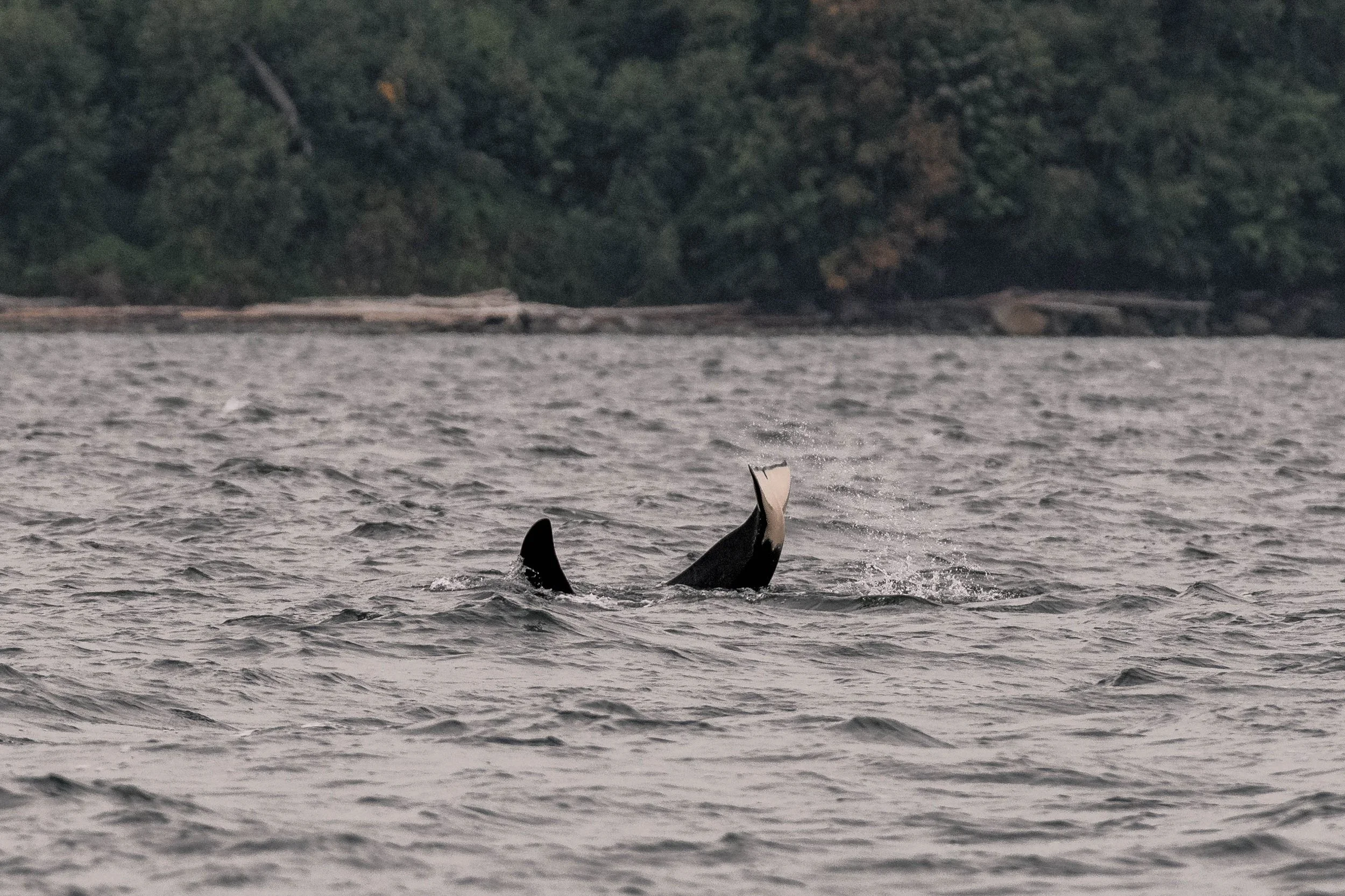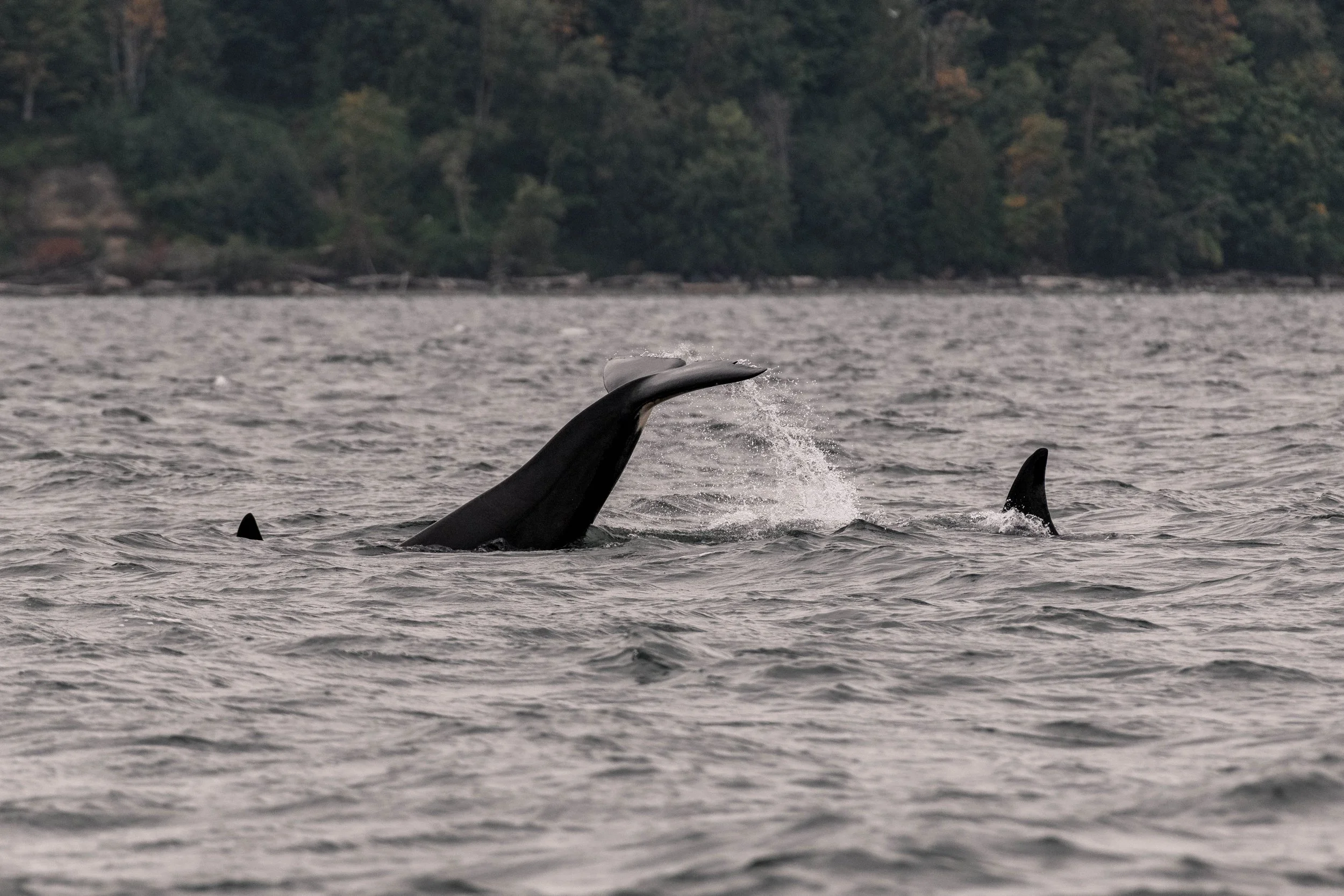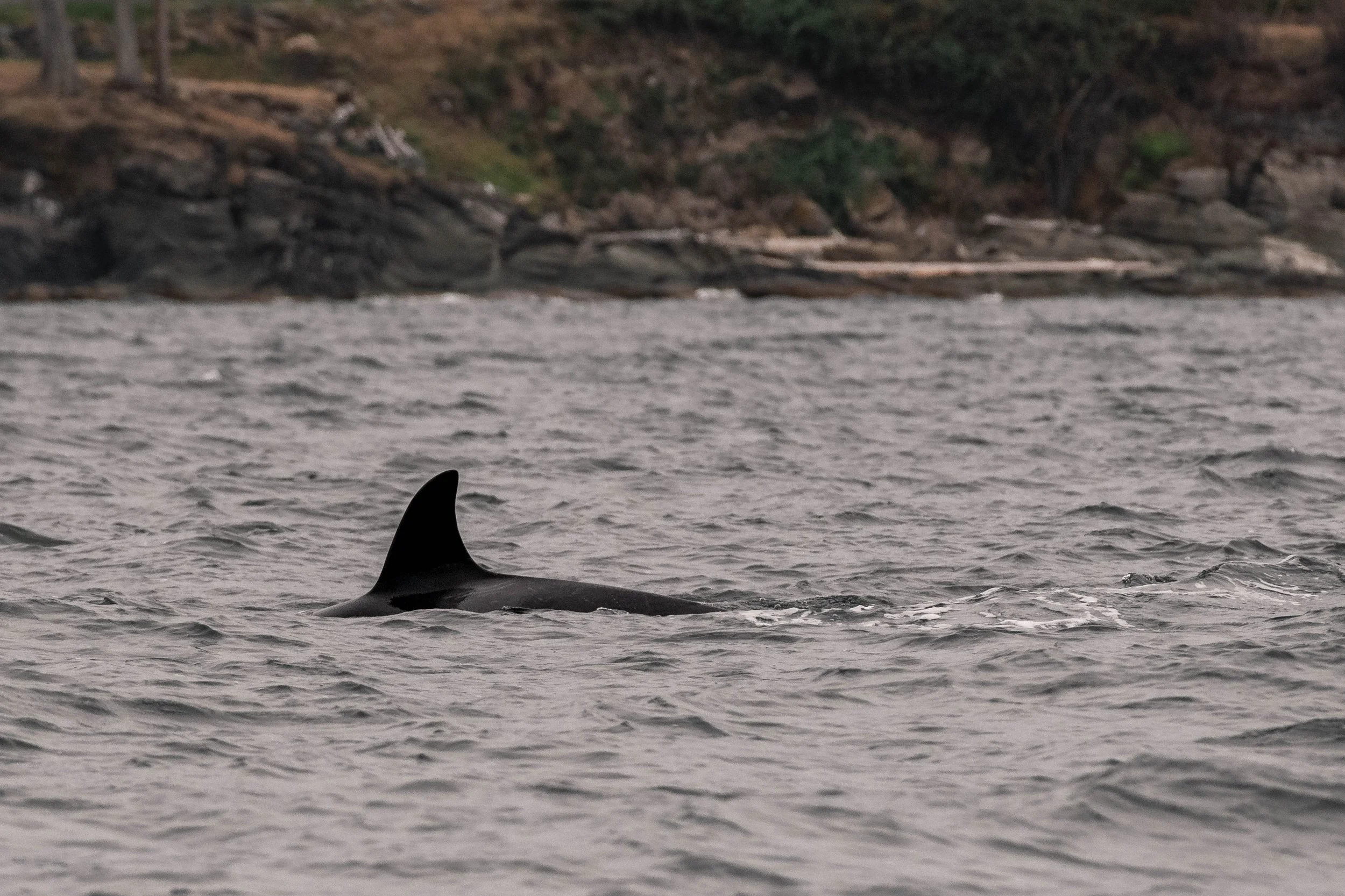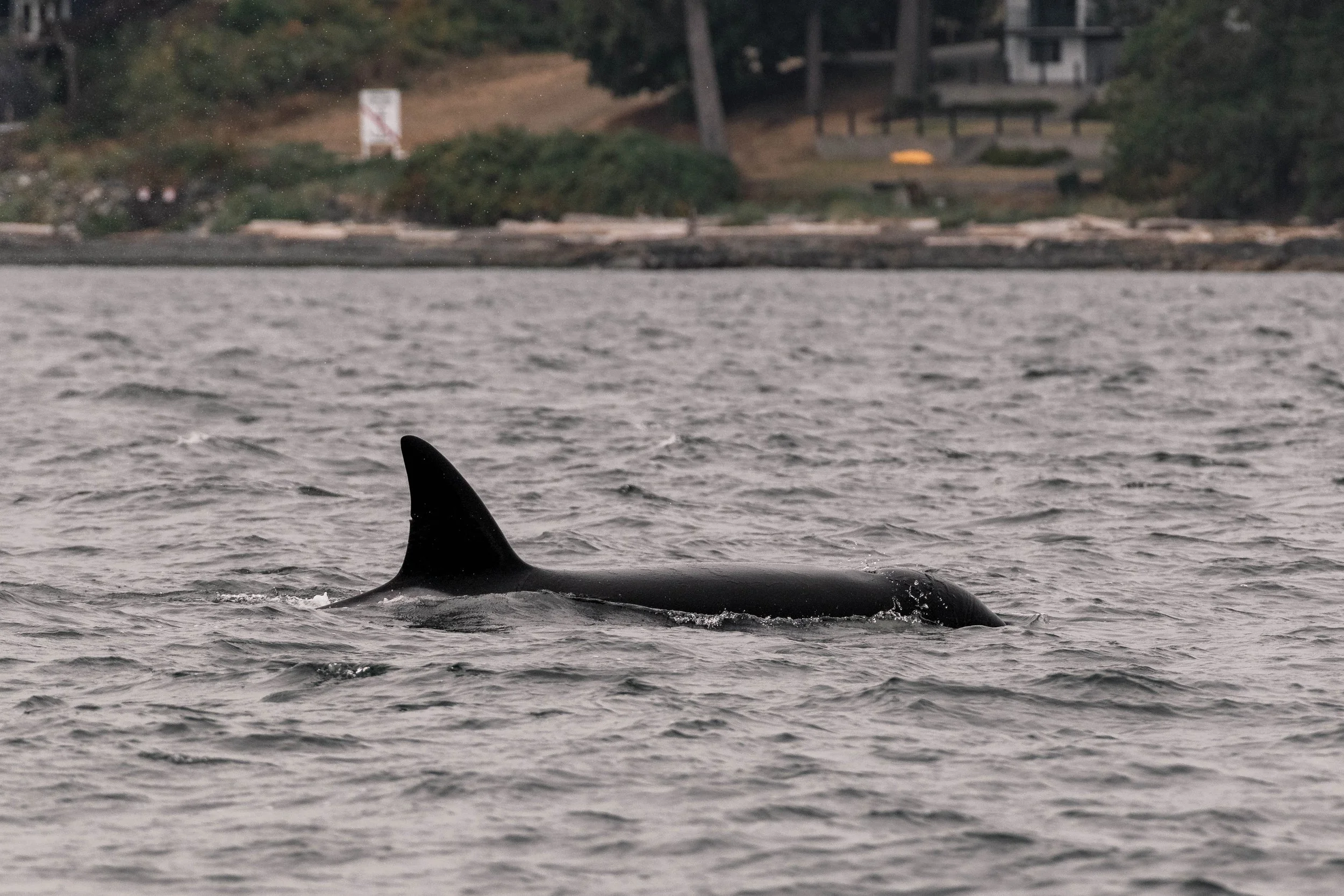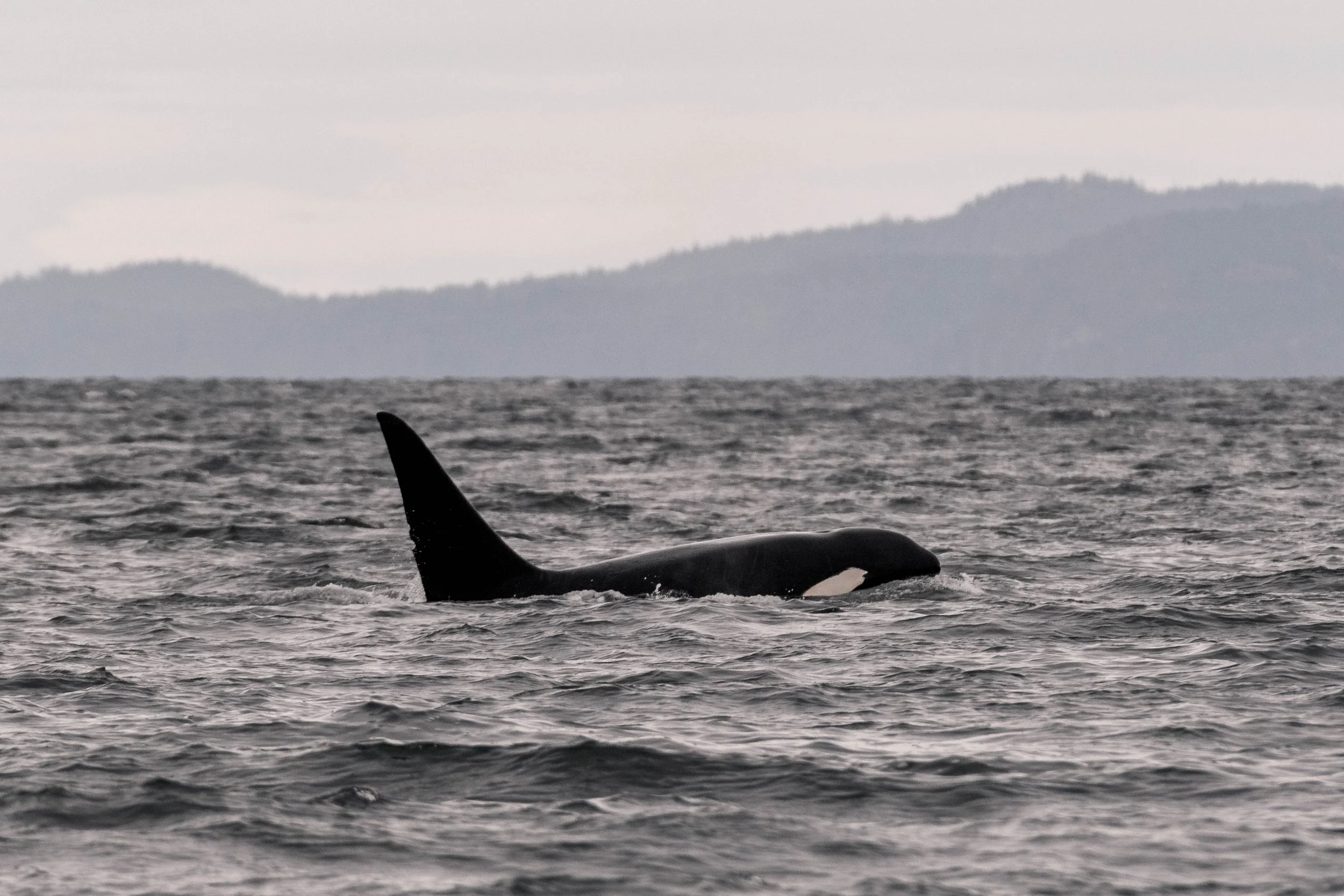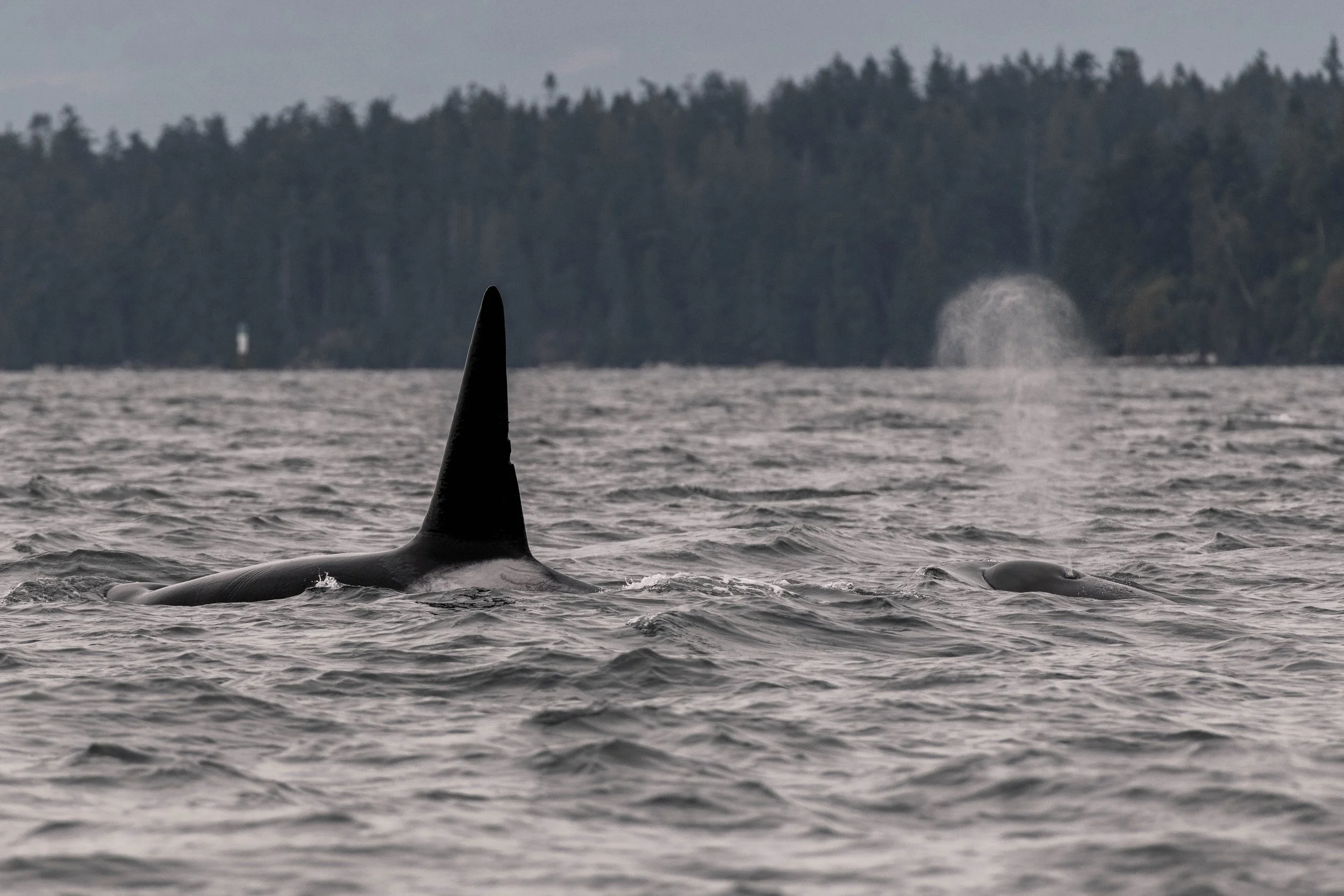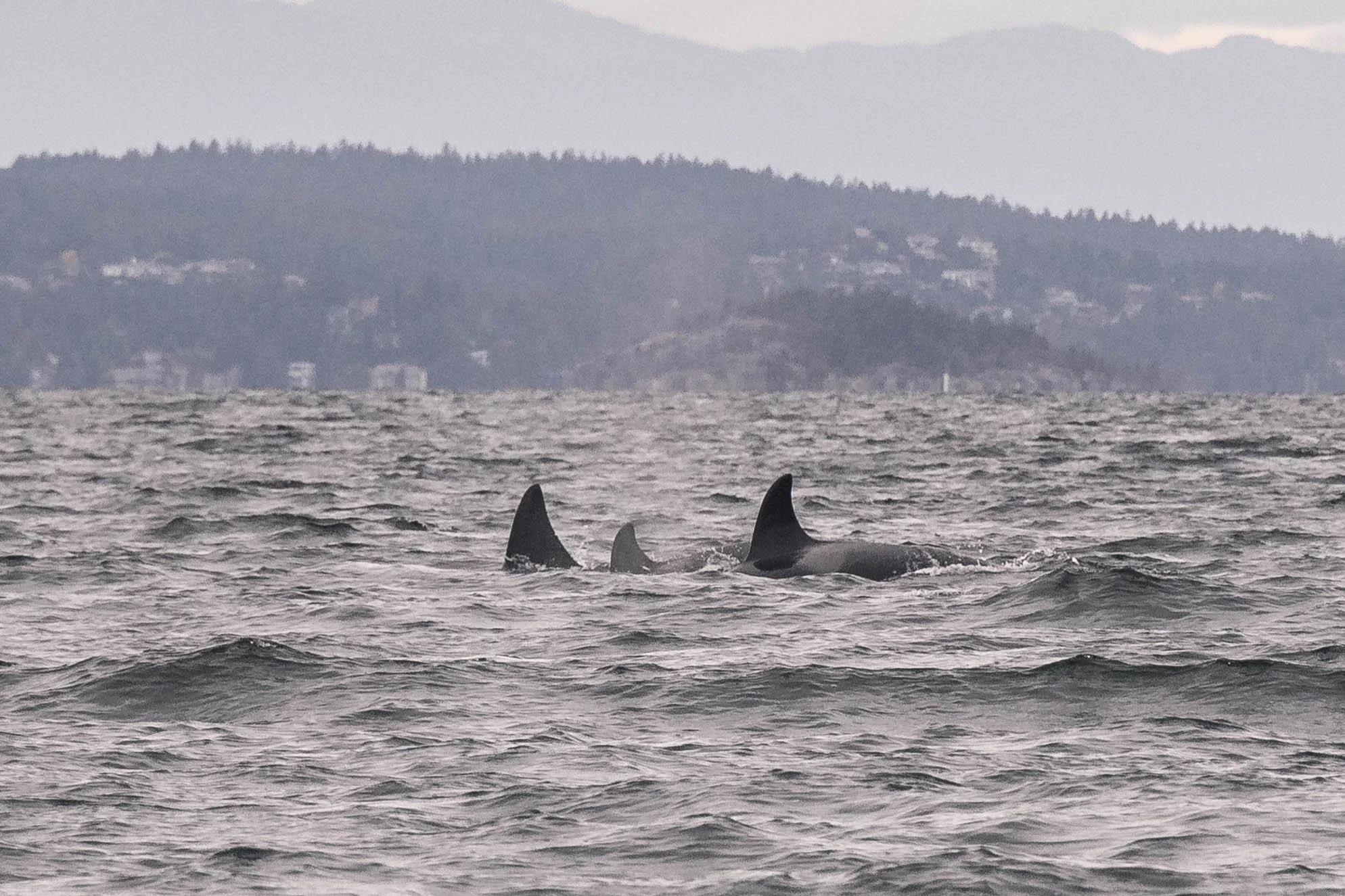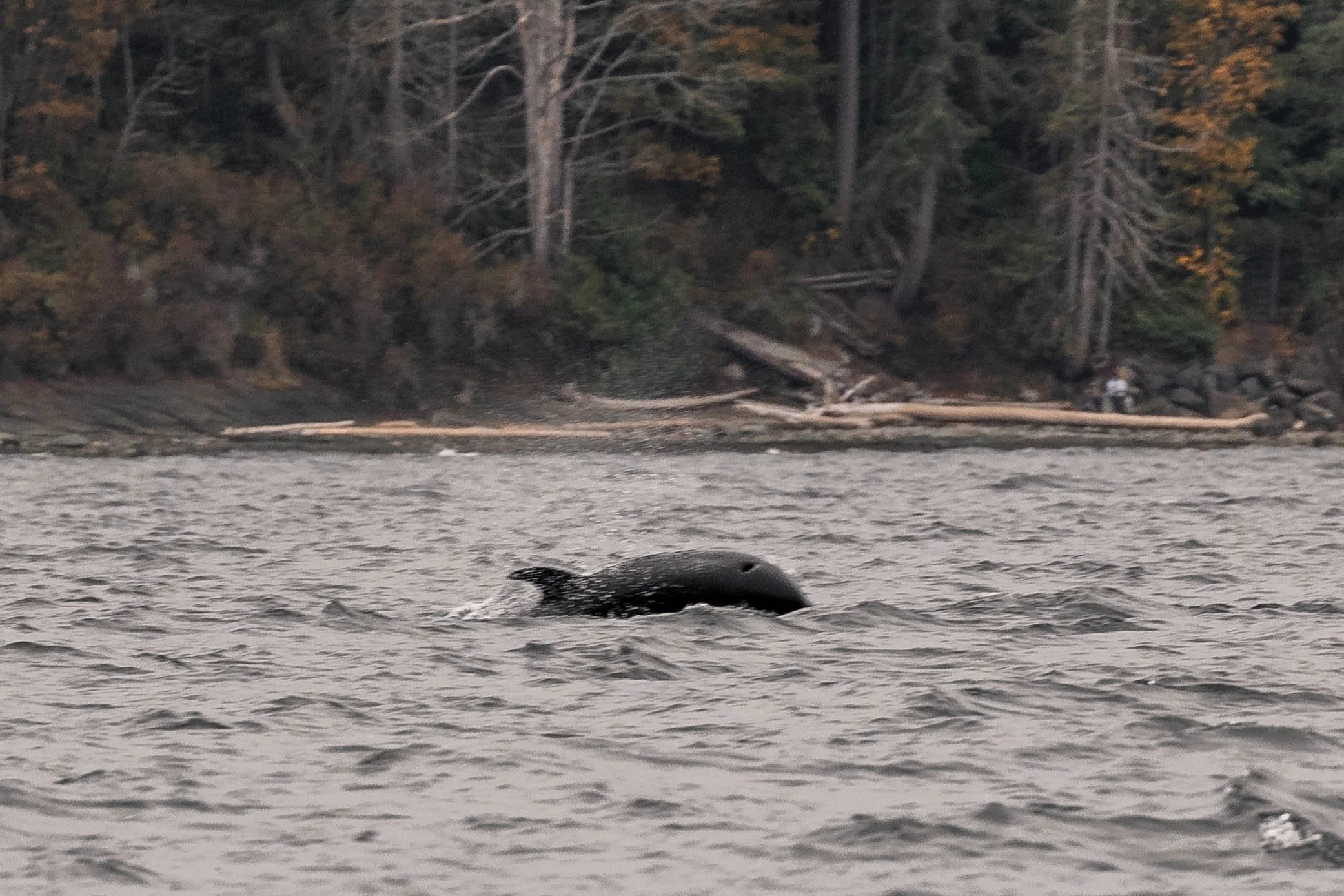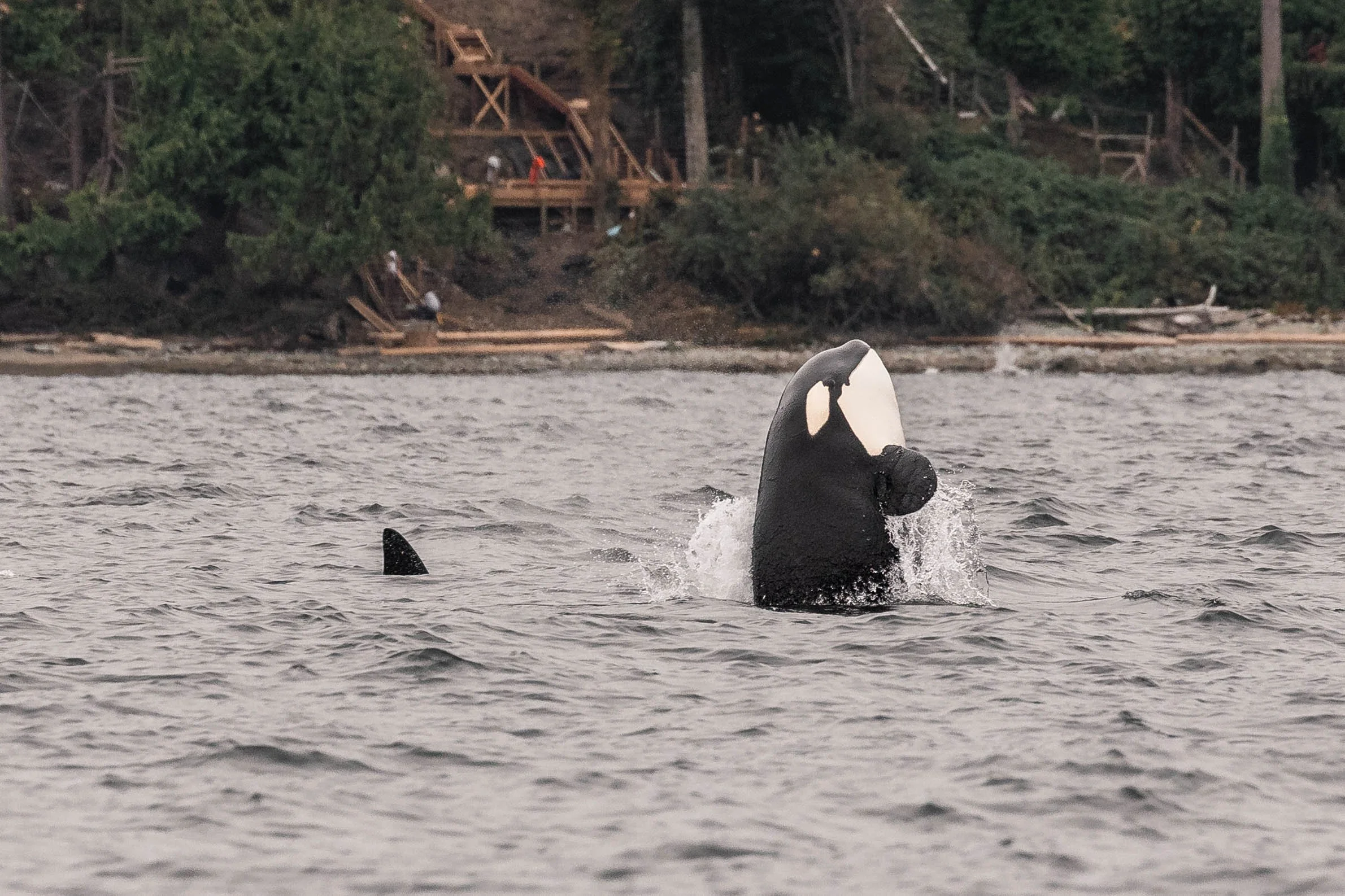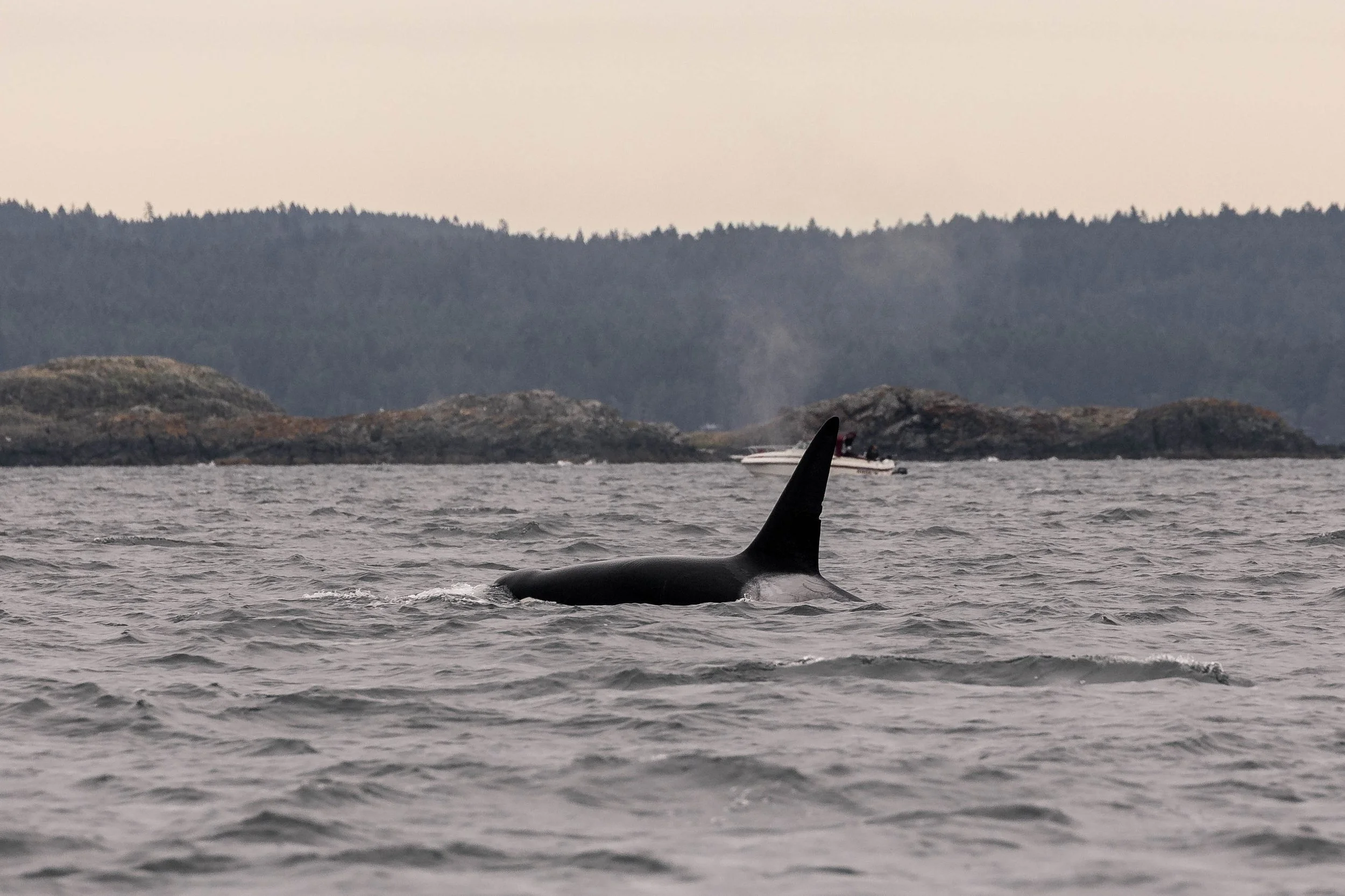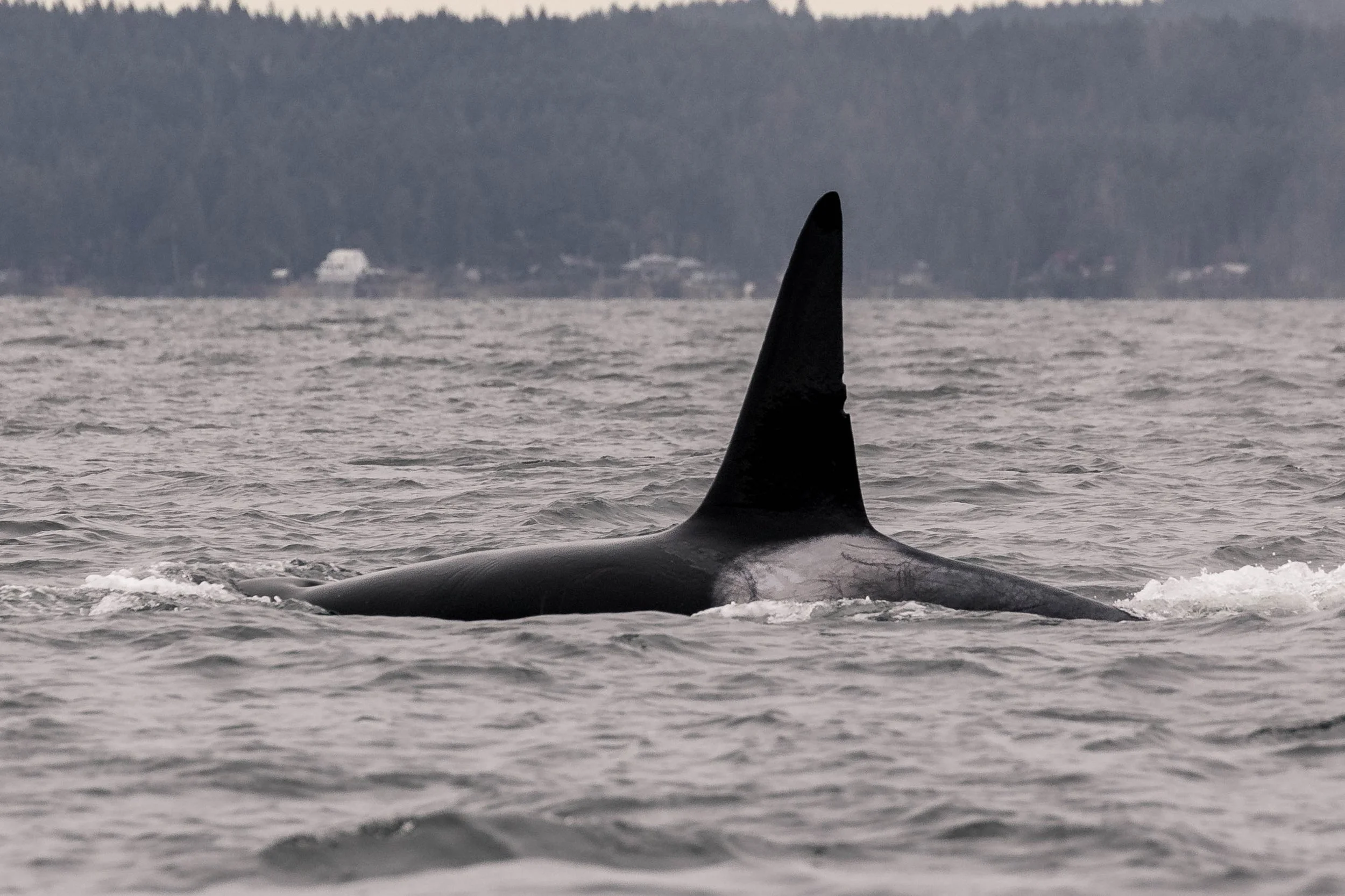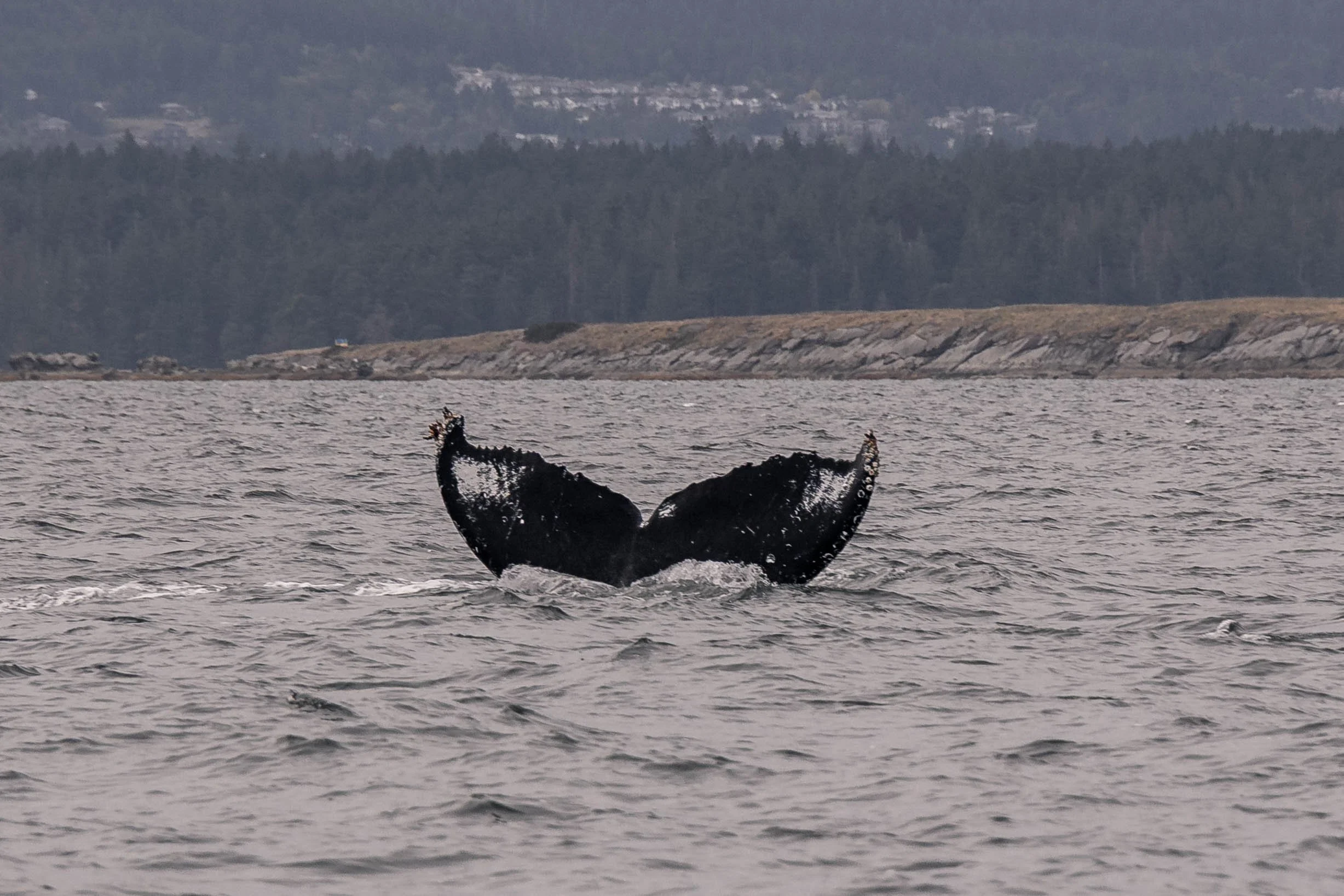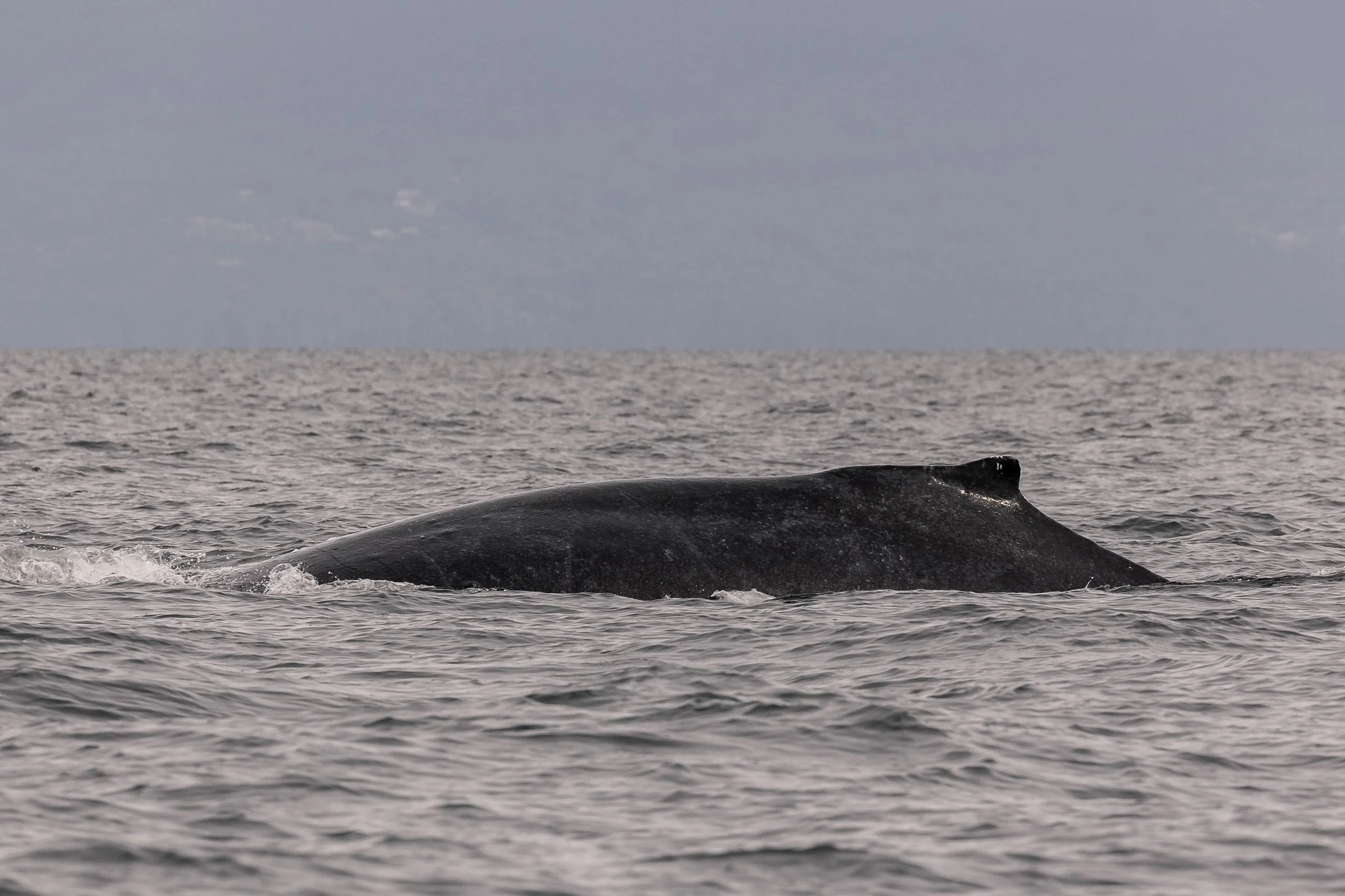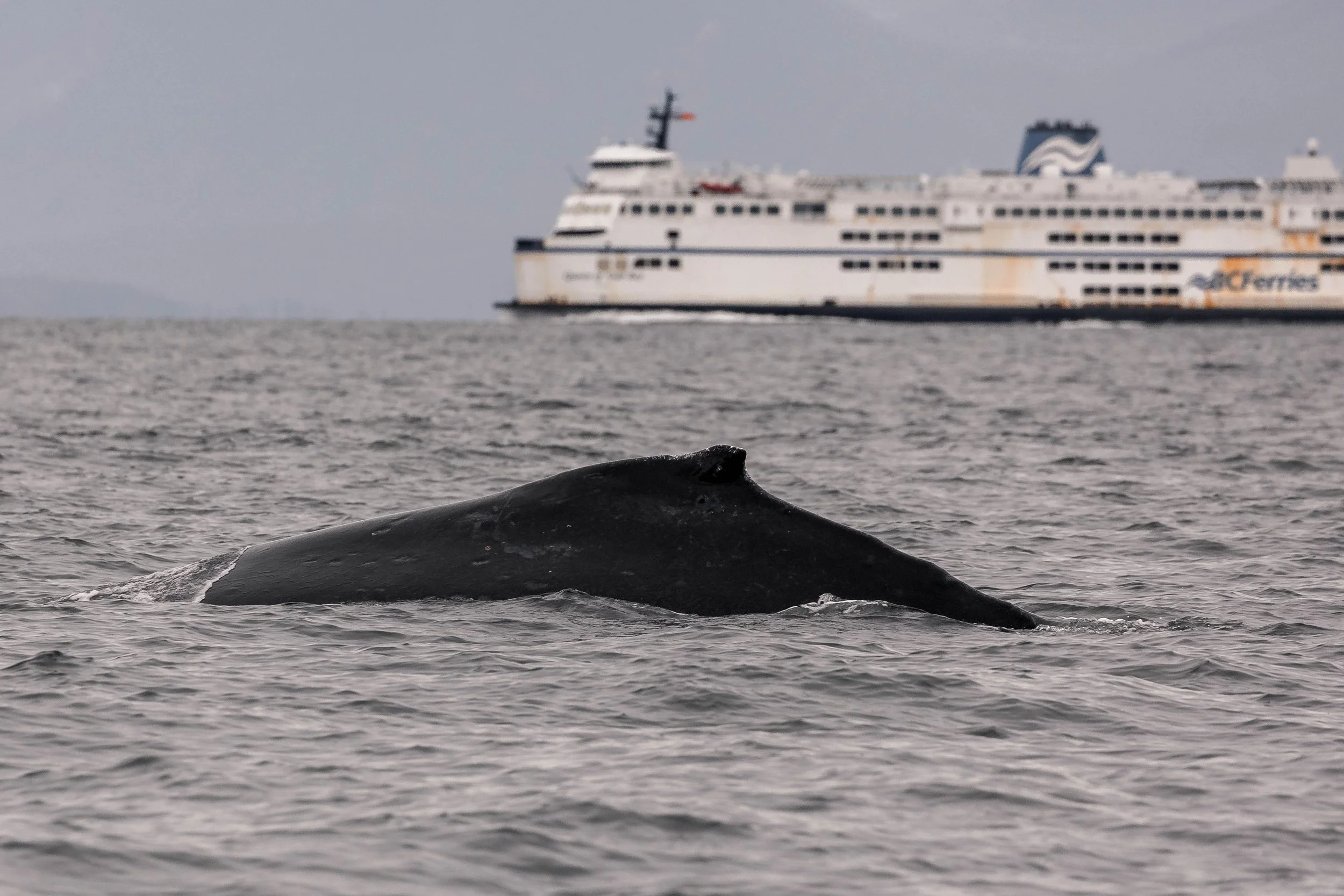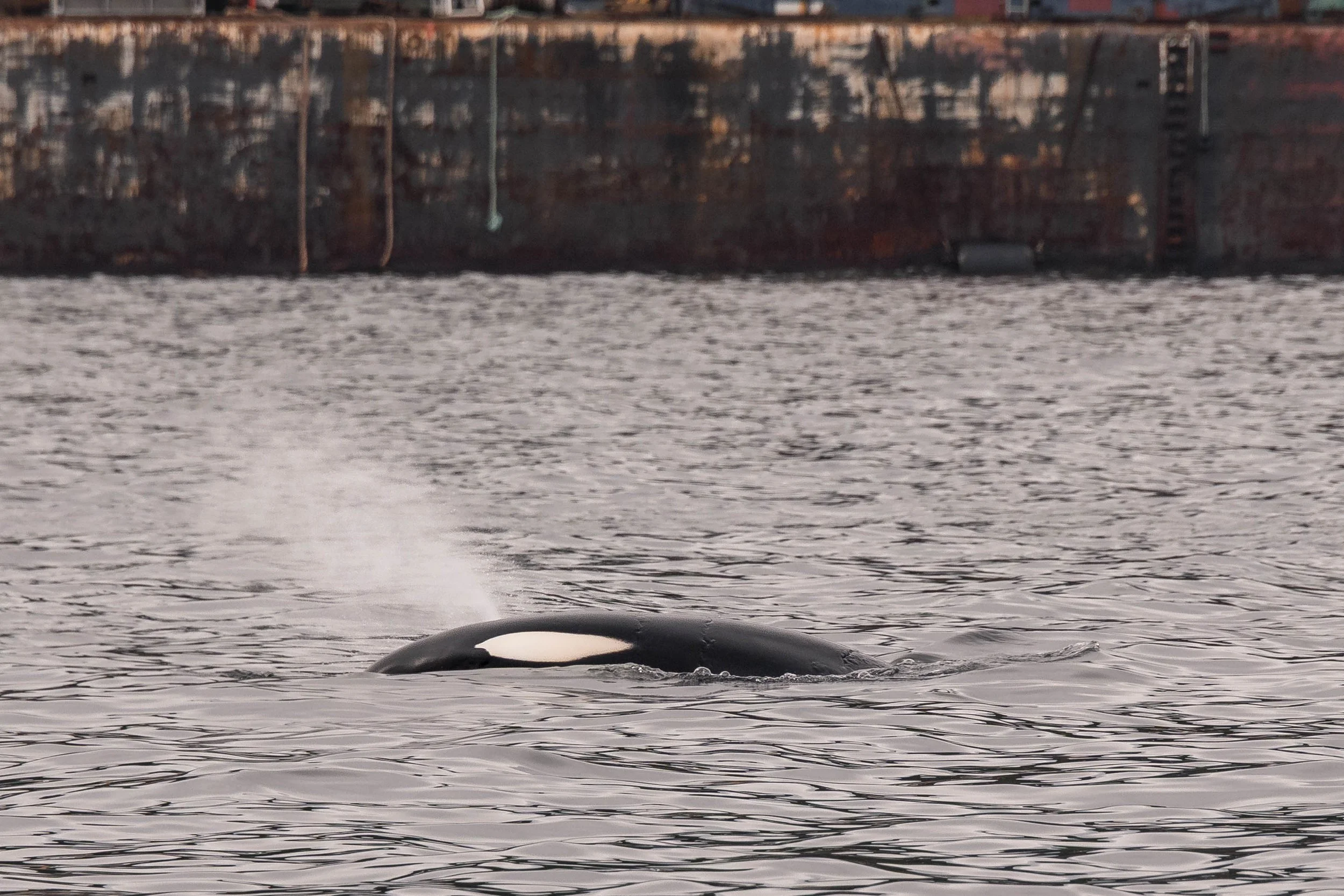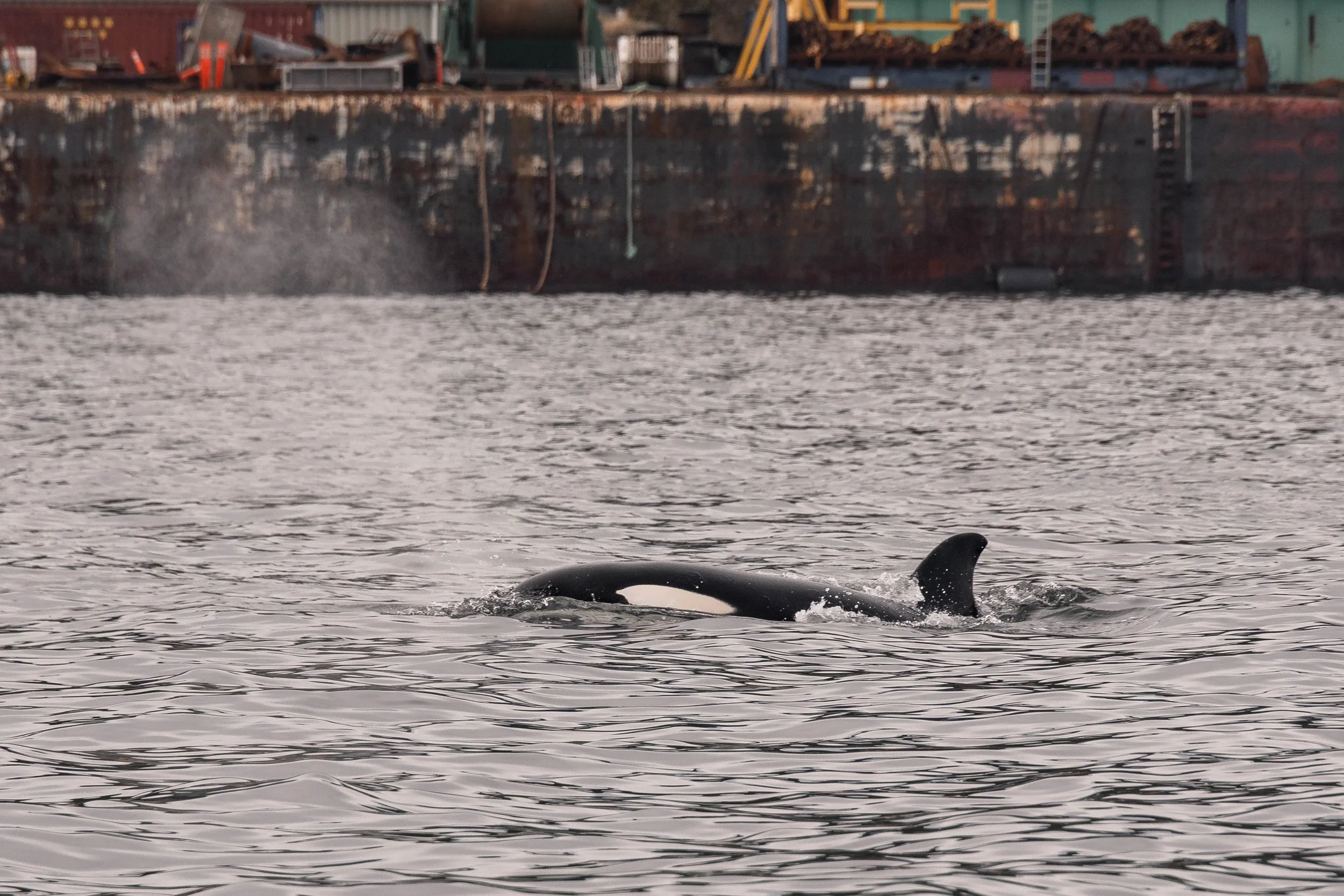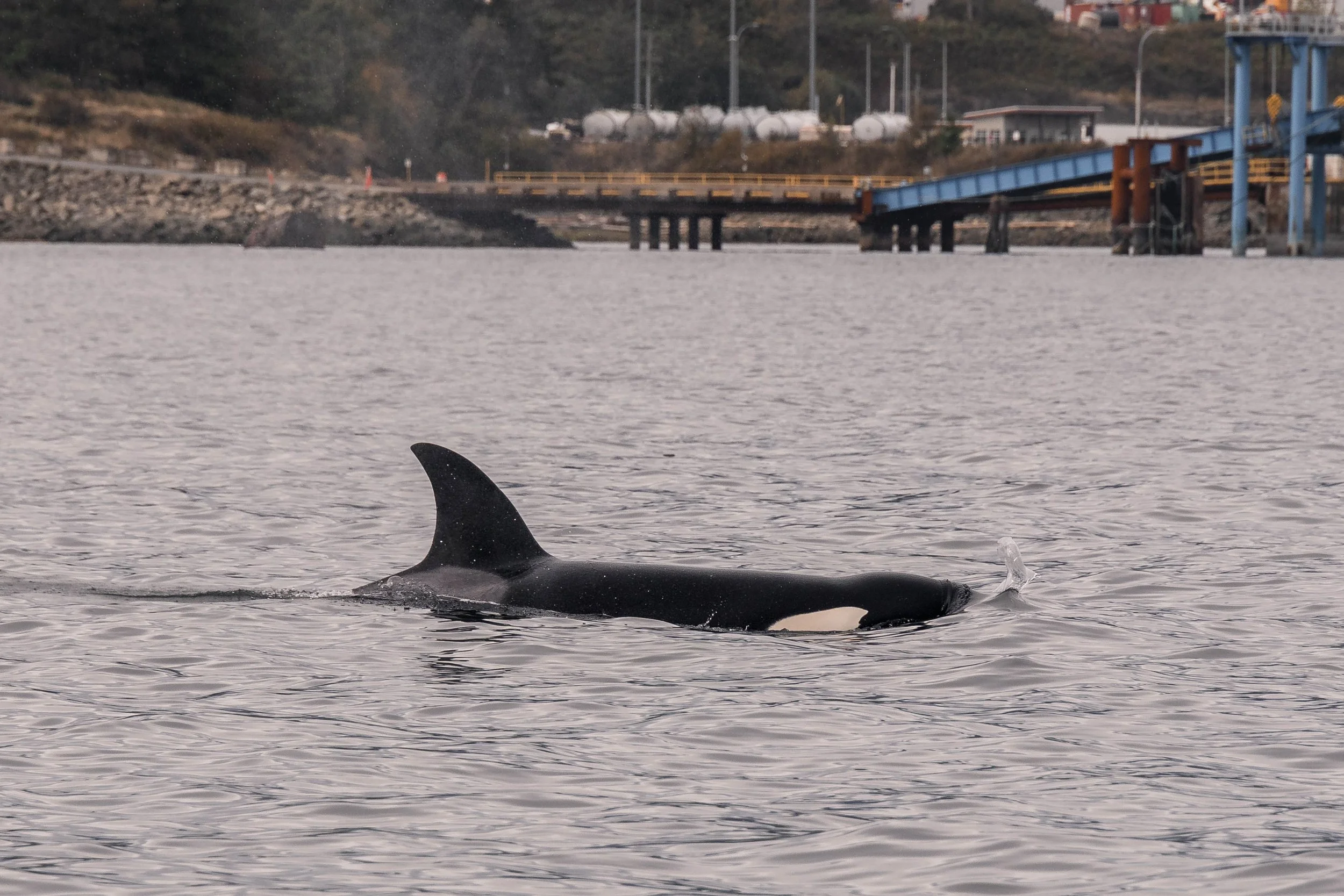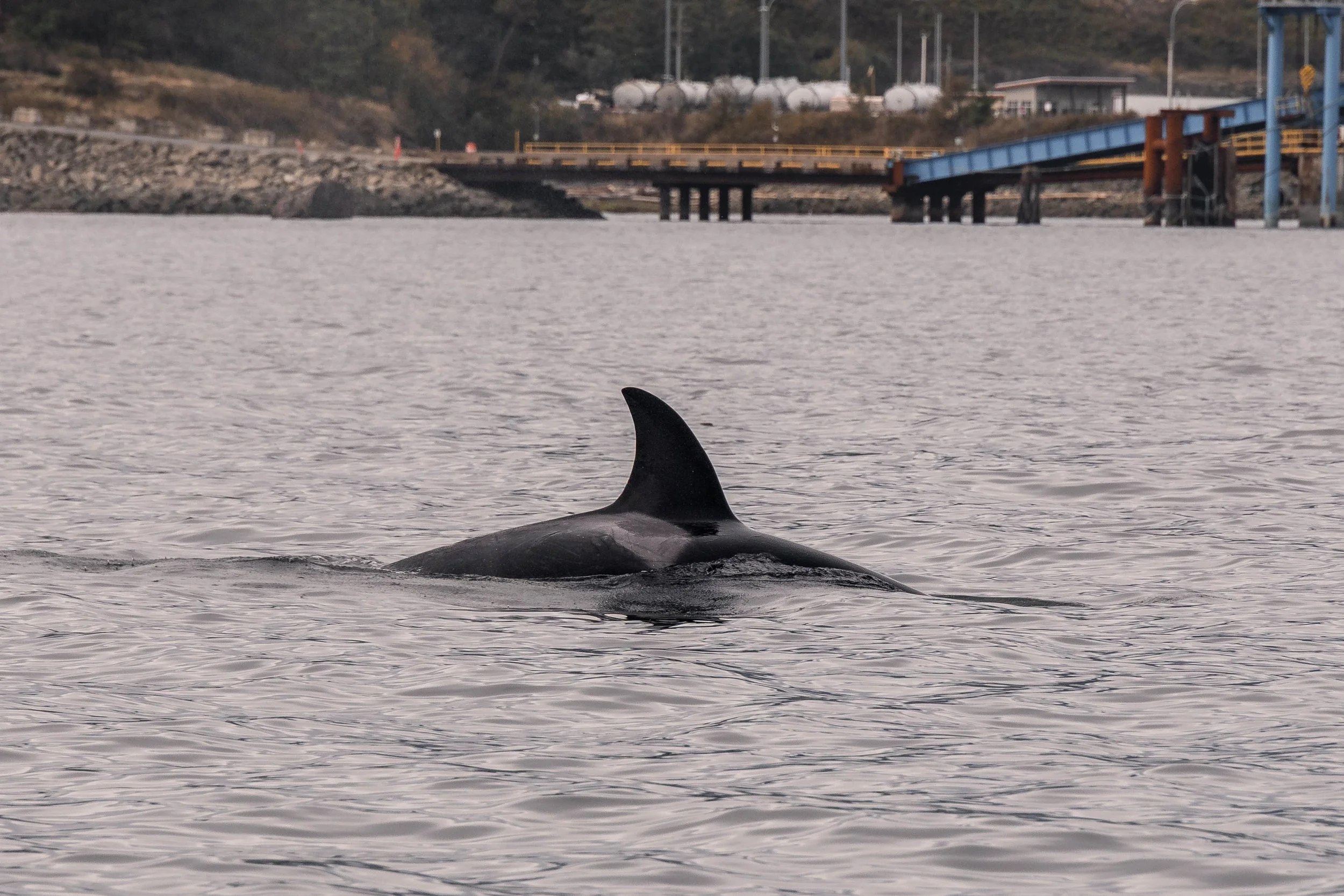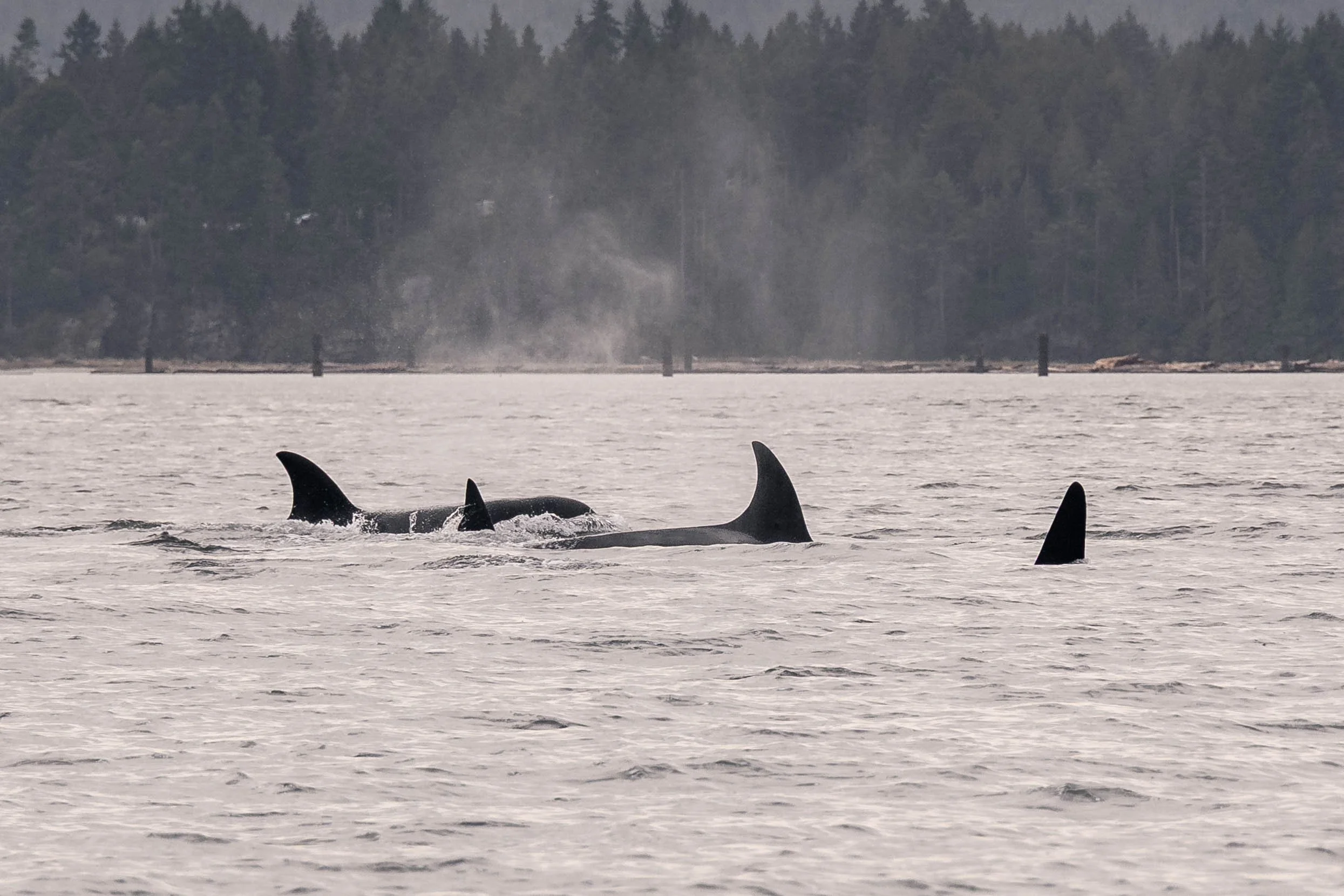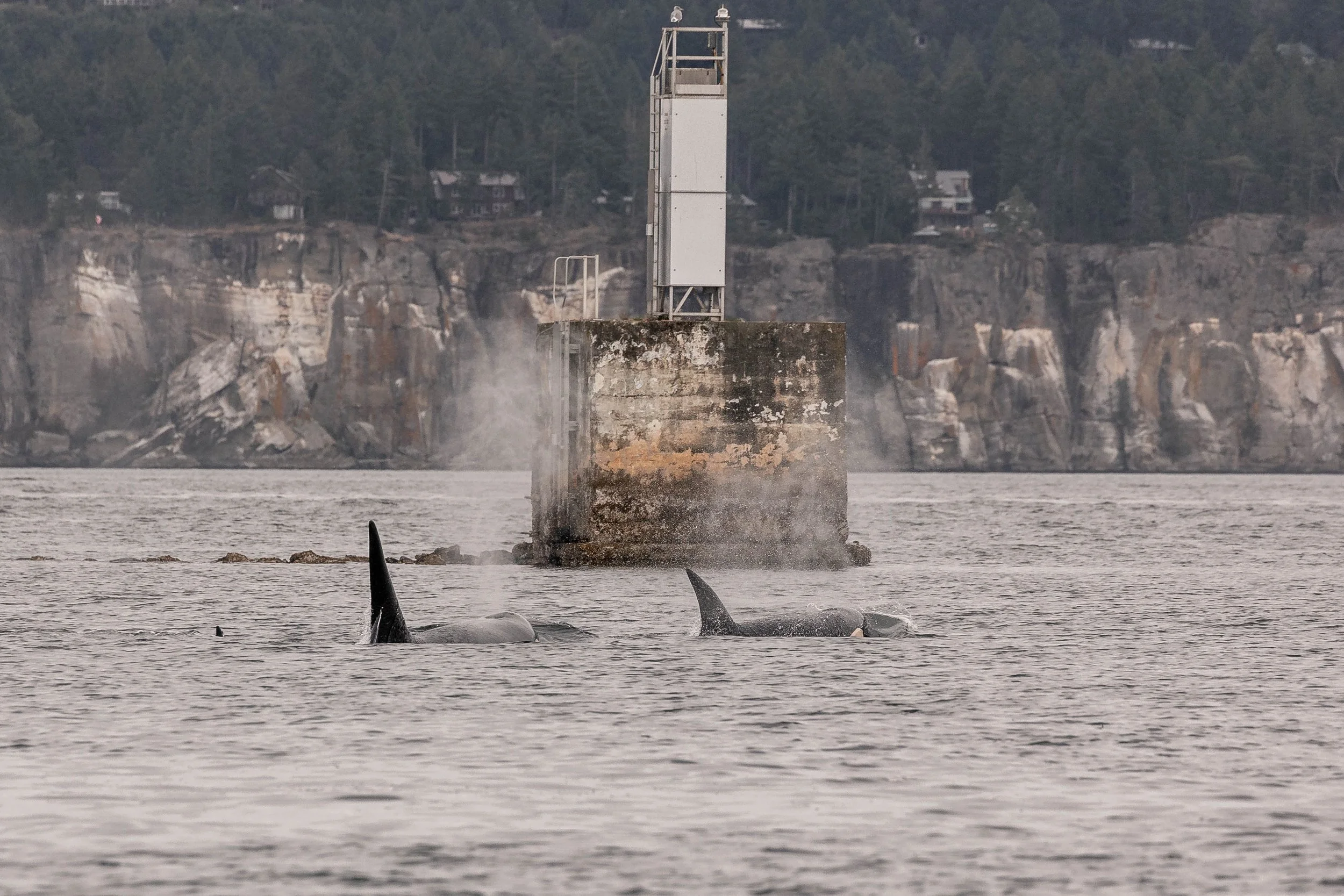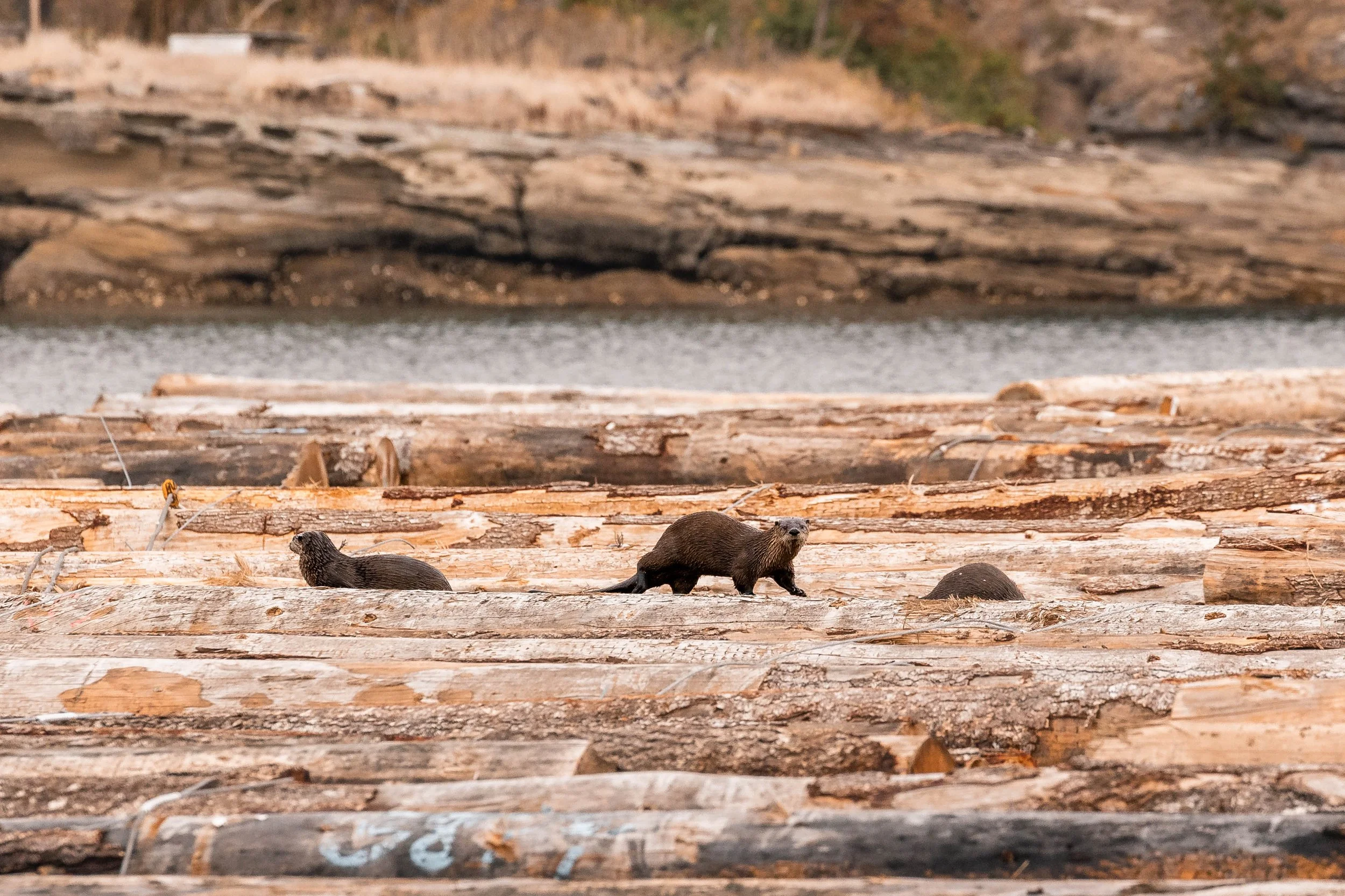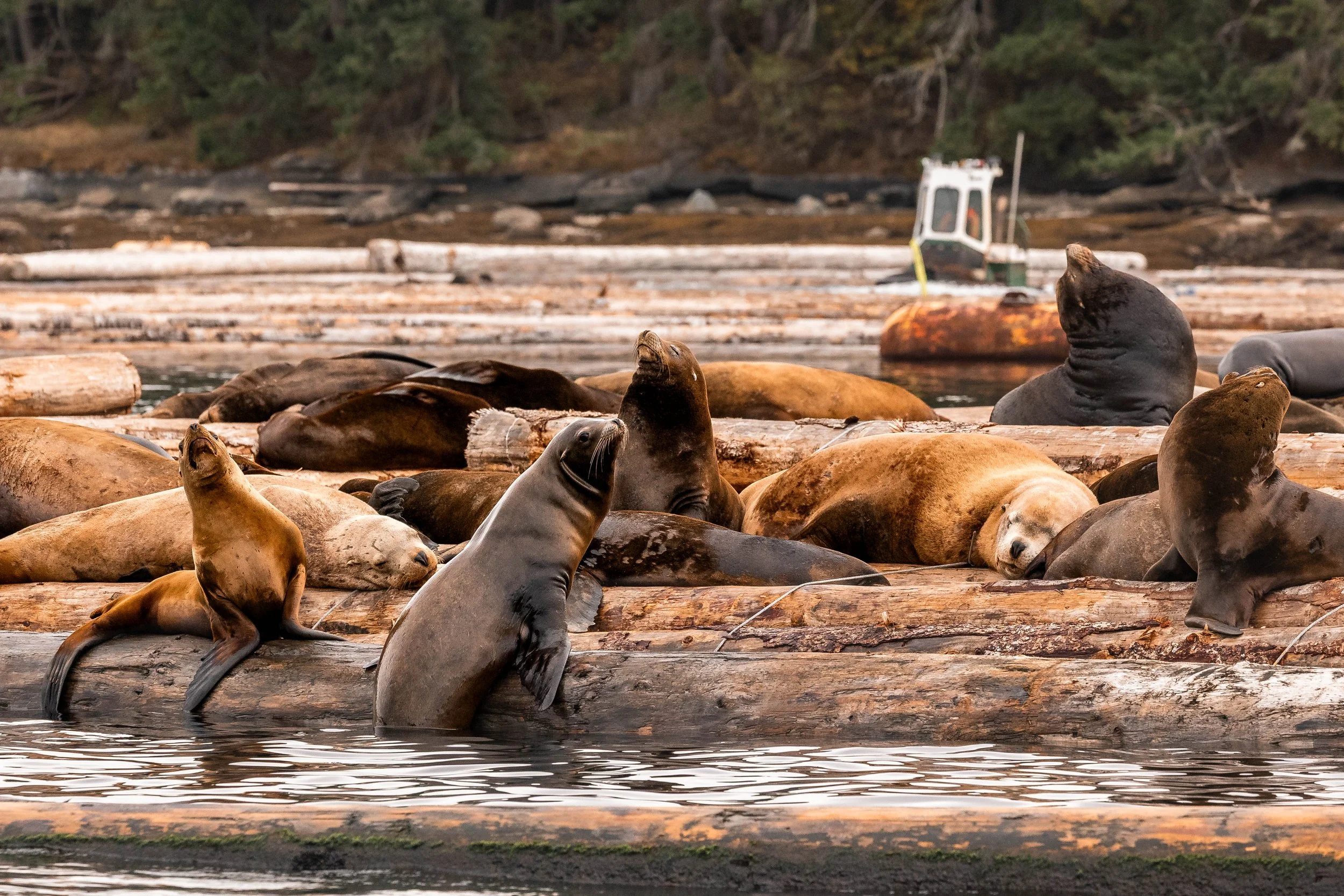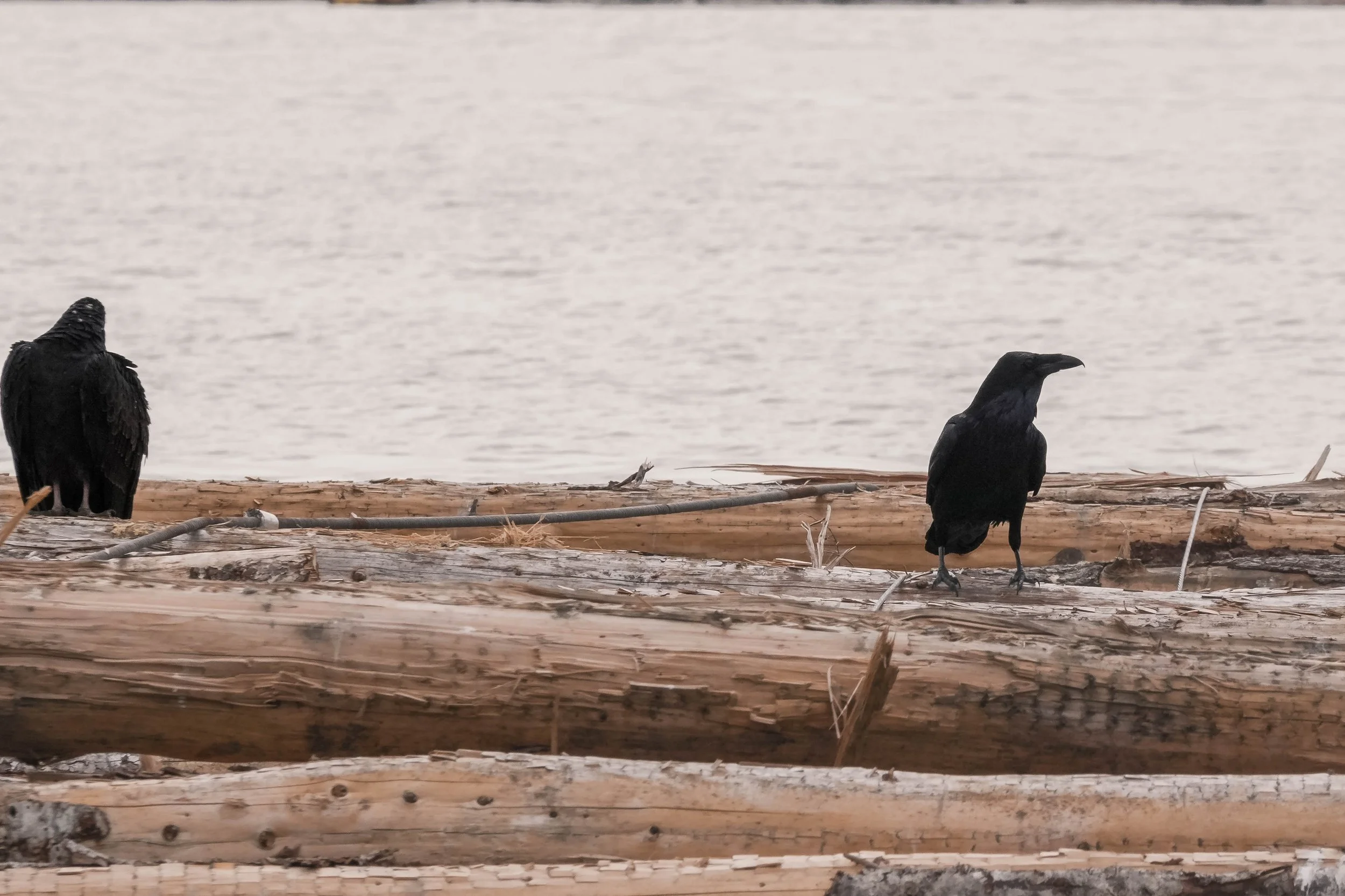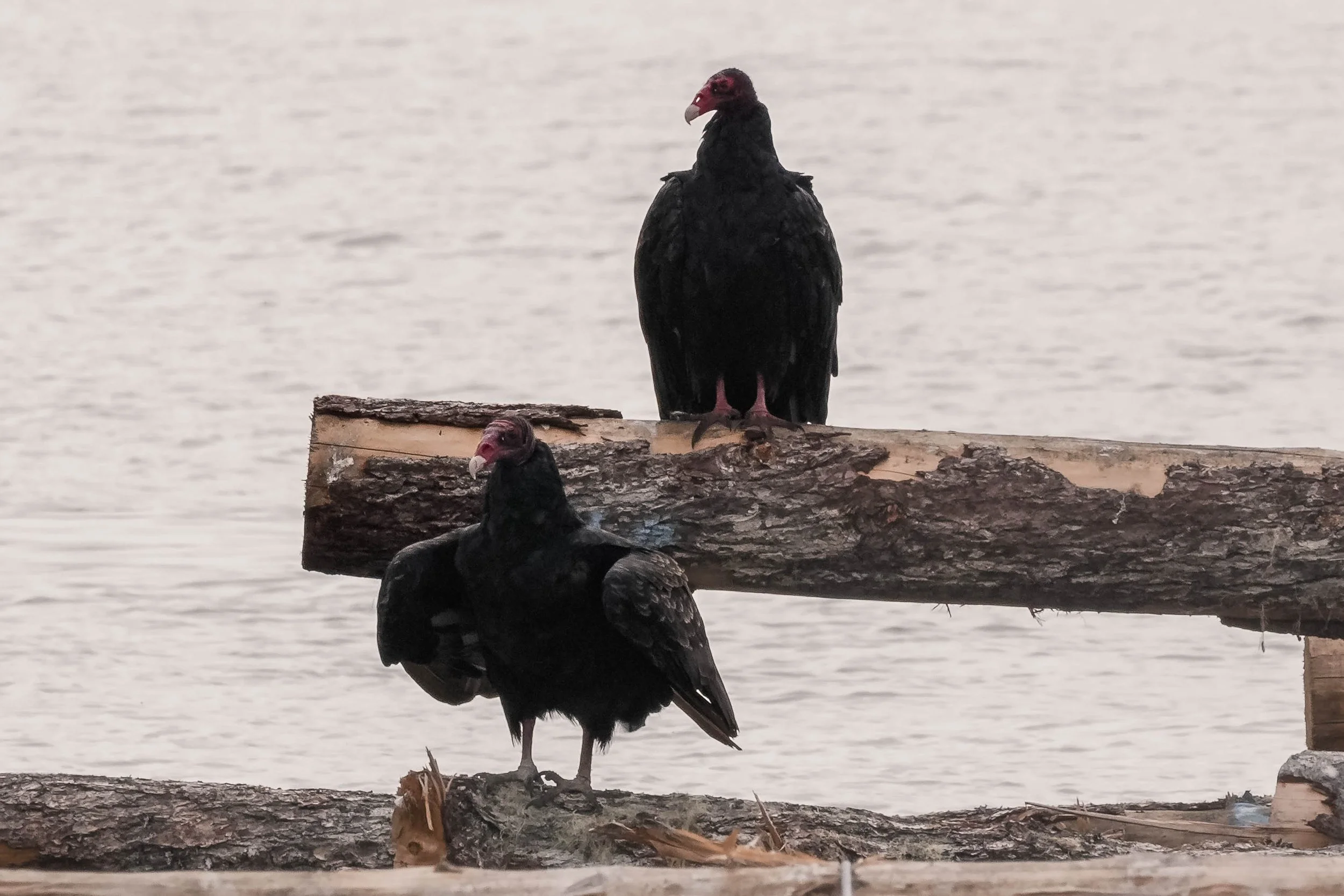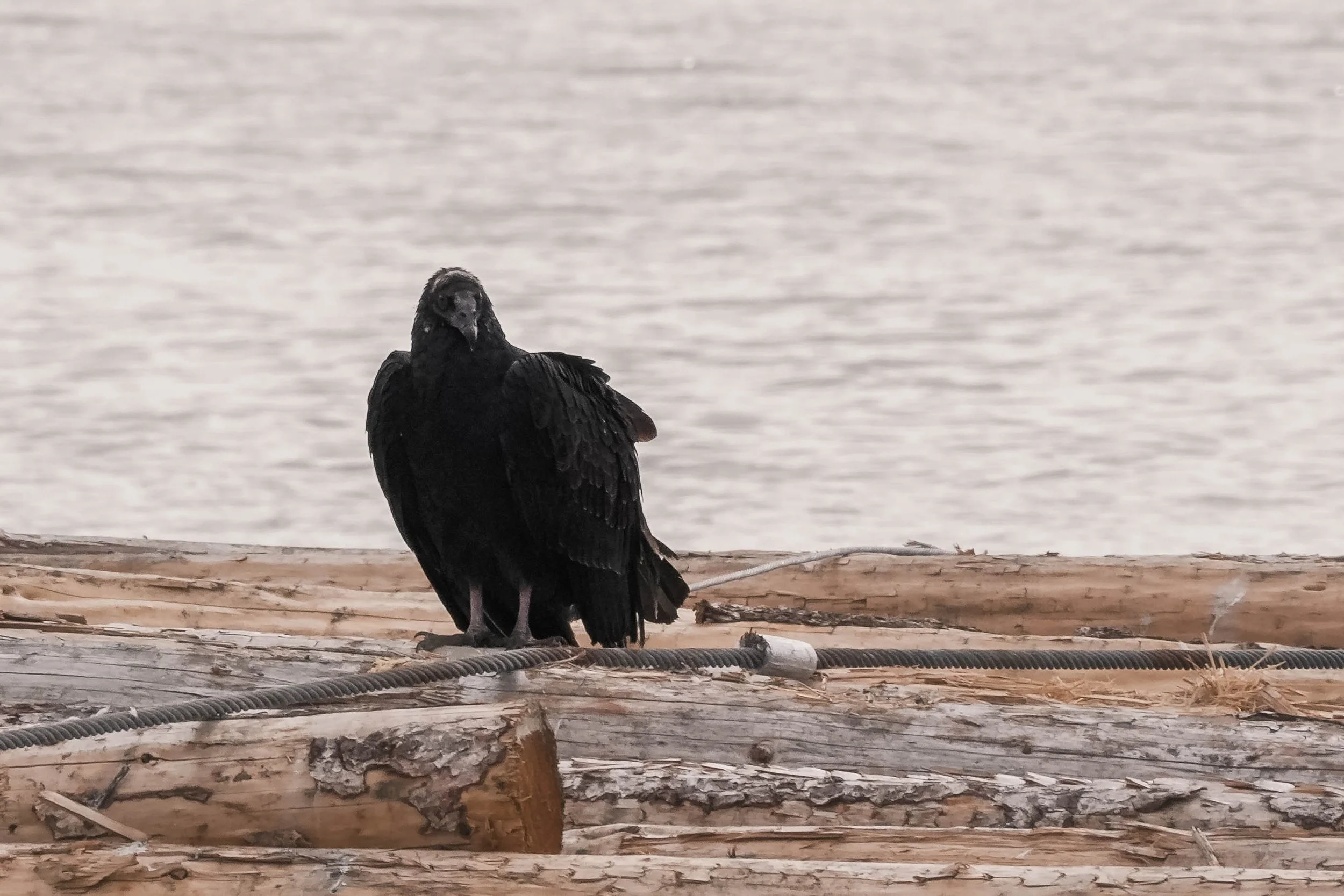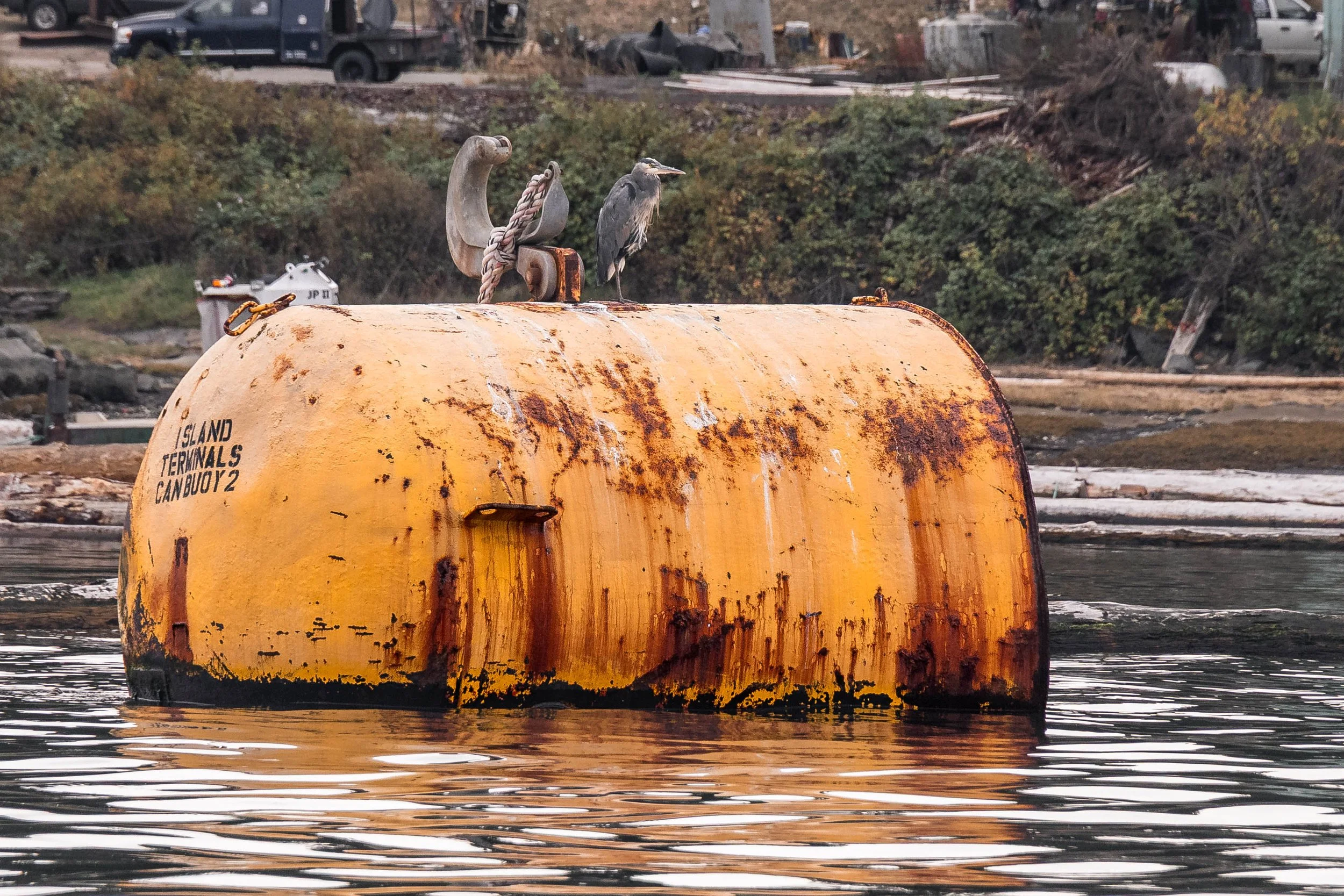September 25, 2025 - Orca off Neckpoint, Humpbacks off Entrance Island, and more Orca off Harmac!
After catching word of a potential whale sighting right in our own ‘backyard' (off of Neckpoint Park), our full fleet departed and turned northward, eager to start the search. We started scanning, and very soon we started to see our first fins slicing quickly through the water! Our Naturalists took their cameras out and began photographing the whales to identify them. For our orca, we usually use photos of their dorsal fins to confirm their IDs. These whales were identified as the T023Cs:
T023C Cindy ♀ (1990)
T023C3 Durban ♀ (2009)
T023C5 Grym ♀ (2018)
T023C6 Cascade ♂ (2023)
These four were very quickly surfacing with several directional changes back and forth. The two youngest members of the pod, Grym and Cascade, occassionally were tail slapping happily at the surface. These four were likely chasing prey around, potentially trying to grab lunch. One of the pod members, Bunzie, was not present with the rest of his pod at this time. We soon found out that he was travelling with another male further out in the Strait! Kula and Cascadia headed over to take a peek at the duo, and began snapping more photos of our new pair. Bunzie’s friend was identified as T049C Nielson:
T023C4 Bunzie ♂ (2013)
T049C Nielson ♂ (1998)
Nielson is a Lone Male. Lone males are not very common in Transient orca, as orca males are huge ‘momma’s boys’ and tend to stick by their mother’s side until their mother passes away. His mother, T049 Charlotte II, is believed to have passed away back in 2007. His sisters, T049A Nan and T049B Van, have both dispersed and have relatively large pods of their own. With his natal pod completely separated, Nielson now travels the seas solo, usually meeting up briefly to associate with other pods before continuing his bachelor lifestyle. Today, he seemed to be happily associating with Bunzie, a male orca from the T023C matriline who is quickly approaching puberty. Was Nielson teaching Bunzie his wisdom, in case Bunzie decides to become a solo bachelor in the future? Were they simply socializing? While we will never know for sure, seeing these two males travel separately from the rest of the pod was definitely an interesting sight to behold!
Not too far south, our Open vessel Keta had found a pair of humpbacks foraging and fluking. After taking some photos, these two were identified as Twinning (BCX1207) and Smudge (BCY0228). Twinning is a relatively old humpback, with their first sighting being documented in 2004. At 21 years old, we assume they are male, as they have never been seen with a calf. Twinning has been cross-matched to our Hawaii breeding grounds. Smudge is an interesting whale, as they have confirmed sightings at both our Hawaii and Mexico breeding grounds. Generally, it is believed that humpbacks return to their natal breeding grounds, or the breeding grounds that their mothers have taught them about. This pattern has changed in recent years, with more and more individuals being cross-matched at both breeding grounds. While we are still unsure why they would change this behaviour, we are eager to learn more, and are hopeful that with continued research and education, we will have a better idea of the social dynamics and travel patterns of these gentle giants!
While Keta was with Twinning and Smudge, Cascadia found another pair of humpbacks a bit closer to Vancouver. These two were Spotlight (BCX1480) and Geometry (BCZ0338). Spotlight, a known female humpback, is a relatively uncommon whale for our area, as she usually spends her summers further north, around areas such as Campbell River. Geometry is a known male humpback, with regular sightings in our waters. While Spotlight’s gender was confirmed from sightings with calves, Geometry’s gender was confirmed by getting a photo of the one area on the body that shows sexual dimorphism in this species. The hemispherical lobe, a grapefruit-sized bump located on the peduncle, is found only on female humpbacks. Scientists are still stumped as to what this lobe does, but if a whale happens to be tail lobbing on the surface, sometimes you are able to get a photo of this area, and are able to confirm their gender (albeit a bit unconventionally compared to orca)!
The fun wasn’t over, though, as we caught word of even more orca in Northumberland Channel! Kula and Keta headed on over, scanning and scanning again. Shortly after beginning to search, Keta saw a little dorsal quickly zooming by. We watched, eager to see who was present. The onboard Naturalist began snapping away, and after comparing photos, this little one was identified as T090D Kanga. Kanga made her way north, and the rest of her pod was spotted shortly after:
T090 Eagle ♀ (1980)
T090B Piglet ♂ (2006)
T090C Tigger ♀ (2010)
T090D Kanga ♀ (2017)
Eagle and her children were busy peeking around the log booms, looking for lunch. After a few minutes of searching, they continued north again. Suddenly, Piglet, the large male of the pod, spyhopped and soon after, they all continued onward northward. They kept travelling and travelling… and then they turned towards Nanaimo Harbour! While whales will usually avoid harbours, occasionally they will peek in for a quick visit. The T090s made their way deep into the harbour, quickly having a look at the docks. They didn’t stick around for long, though, and soon they turned back around, leaving the same way they entered.
After the adventures with the whales, we had one last wildlife sighting over by Harmac with the California Sea Lions. These pinnipeds were busy barking, scratching, and stretching out as we watched them. Besides the sea lions, several Turkey Vultures were wandering the log booms, and we even saw some River Otters running along the logs!
Please enjoy these photos by Marine Naturalists Cheyenne Brewster, Aly Kohlman, and Hayleigh Hilbert.
Flukes up! Photo by Aly Kohlman.
Splashing away! Photo by Aly Kohlman.
T023C5 Grym. Photo by Aly Kohlman.
T023C3 Durban. Photo by Aly Kohlman.
T049C Nielson. Photo by Aly Kohlman.
T049C Nielson with T023C4 Bunzie blowing behind him. Photo by Aly Kohlman.
A tiny little pectoral slap! Photo by Cheyenne Brewster.
T023C3 Durban, T023C5 Grym, and T023C Cindy. Photo by Cheyenne Brewster.
Zooming by! Photo by Hayleigh Hilbert.
T023C5 Grym with her face above the water. Photo by Hayleigh Hilbert.
Coming in for a landing! Photo by Hayleigh Hilbert.
Breaking through the waves! Photo by Hayleigh Hilbert.
T023C Cindy. Photo by Hayleigh Hilbert.
T049C Nielson. Photo by Hayleigh Hilbert.
T023C4 Bunzie and T049C Nielson. Photo by Hayleigh Hilbert.
T049C Nielson traversing along. Photo by Hayleigh Hilbert.
T049C Nielson. Photo by Hayleigh Hilbert.
Twinning’s fluke. Photo by Cheyenne Brewster.
Smudge’s fluke. Photo by Cheyenne Brewster.
Geometry’s dorsal fin. Photo by Hayleigh Hilbert.
Geometry’s fluke. Photo by Hayleigh Hilbert.
Spotlight’s dorsal fin. Photo by Hayleigh Hilbert.
Spotlight’s fluke. Photo by Hayleigh Hilbert.
T090D Kanga with her eyepatch above the surface. Photo by Cheyenne Brewster.
T090D Kanga diving through the water. Photo by Cheyenne Brewster.
T090D Kanga travelling. Photo by Cheyenne Brewster.
T090D Kanga beginning to dive. Photo by Cheyenne Brewster.
A beautifully in focus log boom… T09B Piglet spyhopping behind it! Photo by Cheyenne Brewster.
T090B Piglet. Photo by Cheyenne Brewster.
T090C Tigger, T090 Eagle, and T090B Piglet. Photo by Cheyenne Brewster.
The whole family! T090D Kanga, T090C Tigger, T090 Eagle, and T090B Piglet (tip of dorsal fin). Photo by Cheyenne Brewster.
T090C Tigger and T090 Eagle. Photo by Hayleigh Hilbert.
T090B Piglet and T090C Tigger approaching the tip of Protection Island. Photo by Hayleigh Hilbert.
River Otters scuttling along the log booms. Photo by Hayleigh Hilbert.
Steller and California Sea Lions hauled out together on the log booms. Photo by Hayleigh Hilbert.
Nice and cozy California Sea Lions. Photo by Hayleigh Hilbert.
Carefully watching us. Photo by Aly Kohlman.
A Raven hops along the logs. Photo by Aly Kohlman.
A pair of Turkey Vultures. Photo by Aly Kohlman.
A juvenile Turkey Vulture - their heads are black while young. Photo by Aly Kohlman.
A Great Blue Heron standing on a buoy. Photo by Cheyenne Brewster.
Kula exploring. Photo by Cheyenne Brewster.
Kula watching the T090s with Nanaimo’s skyline in the background. Photo by Cheyenne Brewster.

